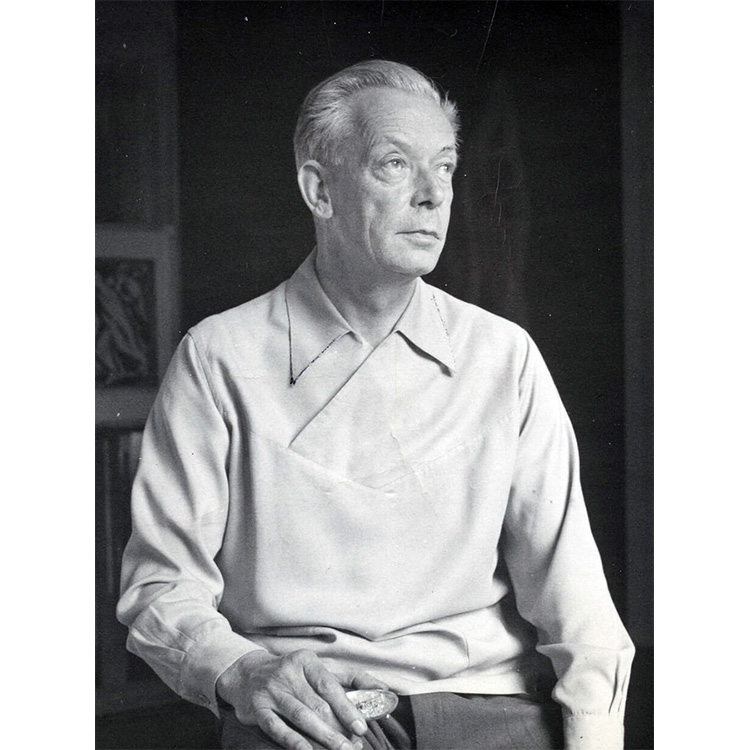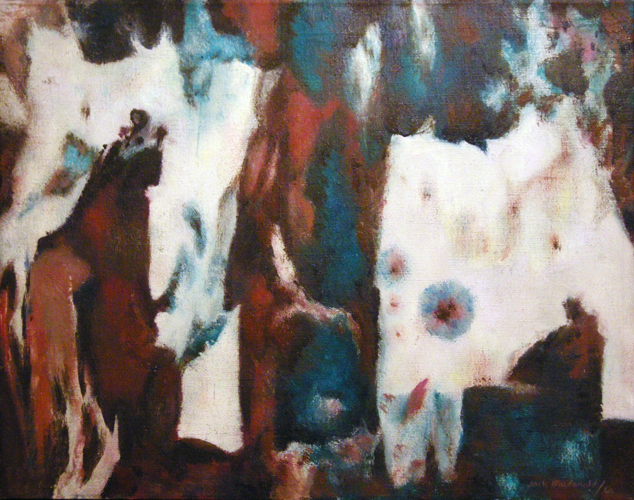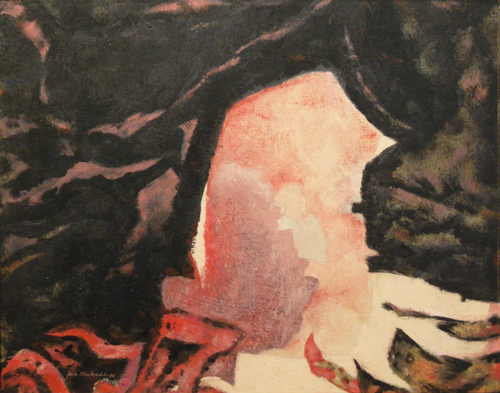Jock MacDonald
Jock Macdonald (1897-1960) – Artist Biography
A painter, watercolourist, teacher, printmaker, illustrator and commercial artist, Jock Macdonald was a significant figure in the development of abstract art in Canada. A contemporary of the Group of Seven, and a close friend of Emily Carr, he was inspired early on by the Western landscape and spirituality. Macdonald was a highly respected, influential teacher and a member of Painters Eleven, Toronto's first abstract art society.
Macdonald was born into an artistic family and apprenticed as an architectural draughtsman. He studied at Edinburgh College of Art under Charles Paine and John Platt, specializing in textiles and commercial advertising, and qualifying to teach art. After graduating in 1922, he moved to England, working first as a fabric designer in Carlisle, and then as a design teacher at Lincoln School of Art. In 1926, Macdonald moved to Vancouver to join the faculty at the Vancouver School of Decorative and Applied Arts (VSDAA). There, he met Frederick Varley, who inspired him to start painting in oils on weekend trips to the nearby mountains.
In 1933, Varley and Macdonald left the VSDAA and founded the British Columbia College of Arts. When the school went bankrupt after only two years, Macdonald moved to isolated Nootka Sound on Vancouver Island, where he found great inspiration in the natural landscape and native culture. Ill health forced him back to Vancouver in 1936, and he took up teaching again. In 1940, Lawren Harris moved to Vancouver and soon introduced Macdonald to the writings of Kandinsky; the two painted together in the Rockies the following summer. Macdonald moved briefly to Calgary in 1946, to take a position at the Provincial Institute of Technology, but went on the following year to the Ontario College of Art in Toronto, where he spent the remainder of his career. He studied with Hans Hofmann during the summers of 1948 and 1949, and in 1953 helped form Painters Eleven. The following year, he went to France on a fellowship and spent several months painting in Vence. There, he met the French painter Jean Dubuffet, who encouraged him to focus his experiments on technique. When he died in 1960, Macdonald was at the height of his expressive powers.
Macdonald's first stylized, linear landscapes were influenced by his design background. Under Varley's mentorship, he became increasingly confident in oil and colour, creating bolder forms. By the mid-1930s, he was already painting his first semi-abstract works, which he later called modalities, and sought a spiritual and symbolic interpretation of nature. Pilgrimage (1937) was inspired by his stay at Nootka. In the early 1940s, Macdonald began experimenting in earnest with automatic watercolour paintings. After his trip to France, he began using Duco and Lucite, fluid industrial paints, as in Far Off Drums (1960).
Macdonald exhibited his work widely both nationally and internationally, and held his first solo show in 1941 at the Vancouver Art Gallery. Affiliated with many artist societies, he was a founding member of the Canadian Group of Painters and Federation of Canadian Artists, and was instrumental in founding The Calgary Group. He was an Associate of the Royal Canadian Academy and a recipient of the Queen's Coronation Medal (1953). Bio c/o: The National Gallery of Canada
Major Retrospective Exhibitions:
1960: Jock W.G. Macdonald, Retrospective Exhibition, Art Gallery of Toronto.
1969: Jock Macdonald, Retrospective Exhibition, National Gallery of Canada, Ottawa. Curated by Dennis Reid and R. Ann Pollock. Circulated by the Extension Services of the National Gallery of Canada, 1969–70.
1981: Jock Macdonald: The Inner Landscape, Art Gallery of Ontario. Curated by Joyce Zemans, with a comprehensive and well-illustrated catalogue:
2014: Jock Macdonald: Evolving Form, Vancouver Art Gallery, in conjunction with The Robert McLaughlin Gallery, Oshawa, January 31–May 24, 2015, and the Art Gallery of Greater Victoria, June 12–September 7, 2015. Curated by Ian M. Thom, Linda Jansma, and Michelle Jacques, with a comprehensive publication.
Artist Specialization: From a background in design, Jock Macdonald turned to landscape painting soon after he arrived in Vancouver, and throughout his life he sought inspiration in nature. In the 1930s he embarked on a lifelong search for a personal abstract expression. His work developed through three distinct styles—the semi-abstract “modalities” of the 1930s, the automatic paintings of the 1940s, and the mature abstract paintings of the 1950s. These stylistic shifts, each one the result of a “breakthrough” experience and what Macdonald called “stepping stones,” occurred about ten years apart, precipitated by either a new source of inspiration or a new technique.



